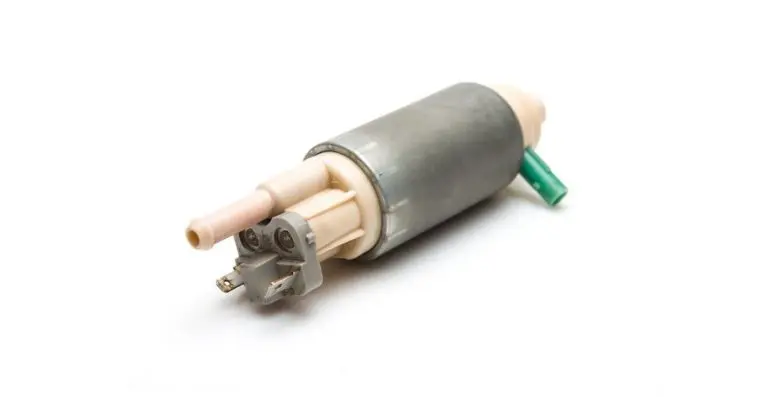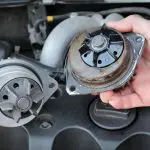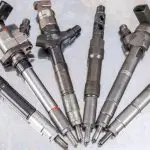You are on the road, and your car suddenly comes to a stop! Clearly, you forgot to fill gas, but the fuel gauge shows that you have fuel; You might actually have a bad fuel pump.
And now you have to get back home or at least to the garage. Here’s how to start a car on a bad fuel pump.
It is not advisable to drive any vehicle if your fuel pump is faulty. It can create myriad issues for the engine. Here’s how you can start the engine with a bad fuel pump.
- Use A Fuel Pressure Gauge
- Apply External Pressure
- Maintain The Engine’s Temperature
A warning first; driving the car with a faulty fuel pump can overheat the engine and burn the pump’s motor leading to expensive repairs.
But, it can buy you some time until you get to a repair shop or the nearest mechanic. That’s the extent you can drive your vehicle since all these are just temporary fixes.
TABLE OF CONTENTS
3 Ways To Start Your Vehicle With A Bad Fuel Pump
You cannot do anything about a failed fuel pump other than to replace it. So, it’s better for your car and purse to get your vehicle checked out if you have any doubts.
Proceeding with a bad pump causes your engine to overheat, leading to extensive damage.
And, any fixes you read here or anywhere else are temporary to achieve one purpose that is to reach your destination.
To start with, it is important to check if the issue is related to the fuel pump or any other components.
Luckily, there are many ways by which you can check if you have a bad fuel pump, one of which is the low pressure in the engine.
The defective fuel pump cannot maintain the pressure needed in the engine and will lower it below the requirements.
It will also interfere with the engine’s air-fuel ratio, which impedes the performance. You can also check for overheating, which is also another indicator of a bad fuel pump.
1. Use A Fuel Pressure Gauge
This is your first and primary option when you are looking to start your car with a bad fuel pump.
It is also dependable that even mechanics use it from time to time when working on a car with a faulty fuel pump.
The fuel pressure gauge, if you have one, is an essential diagnostic one for your car. It helps you check on the fuel line and to make sure that it is running as it should.
It also measures the fuel pressure in the engine to rule out any damage to the fuel pump and injectors.
Affix the fuel pressure gauge to your vehicle’s engine. This will help you start the car and also give you an idea about why your fuel pump is failing.
2. Apply External Pressure
If the first method fails, do not worry, I still have one more for you to try, wherein you apply external pressure to the engine.
Your engine needs sufficient pressure to push the fuel around. With a faulty fuel pump, the pressure is missing, and hence the vehicle might stall and not allow power to reach the engine.
To help the engine with that, give some outside pressure, which will kick start the engine. Once the external source delivers the pressure necessary to fire up, it will get started.
3. Maintain The Engine’s Temperature
Your car might shut down when the engine heats up and not fire up again, especially in the case of a bad fuel pump.
In this case, you can wait until the engine cools down; And when it cools, the fuel pump is reset, and the car might start up again.
So, the best option is to maintain a certain engine temperature and not let it overheat. This will extend the life of the fuel pump for a bit longer without affecting the performance of the car.
Is My Fuel Pump Working?
Before going ahead with any of the steps listed above, you might want to confirm that the issue lies with the fuel pump.
While I gave you a few things to look out for, you might want to be sure of the problem, and here’s how you do that.
This is especially useful if you haven’t had any idea that your fuel pump was going bad.
- Perform these steps in a calm environment. Eliminate any outside noise and switch off your radio or music system. Also, close your windows.
- Turn the key but do not start the engine. The gauges and the warning system should go on.
- Look out for a buzzing sound when you turn the key. It should come from under the car or near the back, closer to the trunk.
- If you are new to this, it might take a few tries to recognize it. It comes on for a few seconds and then goes off. So, you might want to turn off the keys and do the same thing again.
- If there is no noise outside, you can try this with your windows open.
The buzzing sound you are listening for is the fuel pump attempting to prime the fuel system. You can hear it for a few seconds when you turn on the keys. It should sound like an electric motor.
If you cannot hear the buzzing sound, the fuel pressure is missing, and most probably, the fuel pump is the reason.
How Do I Ascertain That My Fuel Pump Has Failed?
This section is for those who know their way around a car and know where things are located.
To start with, inspect the fuse panel and check if the fuse is blown. Some cars might have two fuse panels, and in this case, the one in the engine compartment is the one to see.
It is otherwise called the circuit box, and you can find it near the battery. It is a black box, smaller in size with a detachable lid.
Broken Fuse
For the fuse index, you can see the inside of the lid.
Most manufacturers provide a list of the fuse indices by position and number. If it’s not available there, you can check the owner’s manual for the same.
Now to check the fuse, take off the fuse and check the element, if it’s broken or intact. If broken, you can fix it yourself. Locate some spare ones in the fuse box itself and replace the blown fuse.
Ensure that you use the right fuse by cross-checking the AMP number with the one mentioned in the original fuse.
Fuel Pump Relay
If the fuse is intact, you might want to examine the fuel pump relay. It is also present in the same fuse panel; check the owner’s manual or the lid for information on the location.
In the case of a relay, you would not be able to test without any proper tools, but you can follow the below steps for an alternate route.
Most relays in the fuse panel have the same AMP and size; So, switch the relays with a similar one (rating and size) and start the car.
You can also try to listen to the fuel pump, trying to work by turning the keys.
Fuel Pump Circuit Breaker
If your fuel pump fuse is missing, you might want to check for a fuel pump circuit breaker since certain cars have this instead of a fuse.
You can consult with the owner’s manual for the location of the same. The breaker is usually a button that pops up when the fuse trips. If you find it pushed out, press it until it pops in.
4 Signs Of A Bad Fuel Pump
The fuel pump is a crucial part of the engine’s fuel system, and when it malfunctions, the engine will not get its fuel in time.
And hence, you can visibly see a decline in its performance, even if you try to push the vehicle.
Here are a few signs that you can see in a car with a faulty fuel pump. It goes without saying that when you see any of these in your car, take it to the nearest mechanic or repair shop and get it checked.
1. Will Not Start
The fuel pump starts with the engine and keeps going. Hence, it can give to wear and tear and degrade over time.
A weak fuel pump still holds on but will not be able to provide the engine with the necessary pressure.
This lack of pressure can be rather obvious as the days go on starting, with difficulty in starting. It can take quite a few cranks to start and reach a point that it will crank but not start.
However, if possible, check your fuse panel for a blown-out fuse, and also fuel pump relay before blaming it on your fuel pump.
2. Engine Stalls When Overheating
Your engine can stall for many reasons, but if it happens when the engine overheats, your faulty fuel pump may be to blame.
In case the stalling continues with every temperature increase, it means that the fuel pump has started failing and might require a replacement.
3. Engine Sputtering
If your engine sputters, especially when traveling at high speeds, it is a sure shot indicator that your fuel pump is giving up.
This is due to the inability of the pump in delivering a constant flow of fuel at the right pressure.
4. Engine Surging
If your car suddenly surges when traveling at a steady speed, it is an indication of a bad fuel pump.
This happens due to the fuel pump’s inability to send a constant stream of gas, but instead, it sends it in spits and stops.
However, this might also be due to bad gas. Whatever it is, you might want to consult with a technician.
FAQs
Q1. What Happens If My Fuel Pump Fails?
A faulty fuel pump causes a decrease in engine performance and driveability issues in cars. It creates a disturbance in the air to fuel ratio, which leads to the cylinders not getting enough gas.
As a result, the piston doesn’t fire with the engine overworking to push forward.
As many of you imagine, it is not about poor mileage or inefficient performance. In the worst case, your car would not start.
Q2. How Long Does A Fuel Pump Last?
Fuel pumps are supposed to be resilient and last for a long time or even as long as the car lasts. They are known to endure more than 200,000 miles.
However, after 100,000 miles, if you are changing any component that plays a significant part in the engine, expect the fuel pump also to fail soon enough.
Q3. What Causes A Premature Fuel Pump Failure?
As long as the engine operates, the fuel pump is too working, providing it with enough fuel to get the car going. In order to stay cold, it stays submerged in the fuel at all times.
However, if you empty the tank at all times before filling in the gas again, the fuel drains away from the chamber completely, leaving it to dry.
If you keep doing the same repeatedly, your fuel pump gets hot and burns out fast.
Conclusion
A bad fuel pump might prevent your car from starting, especially if it reaches a point when the engine is overheating.
At this point, it is safer for you and the engine to have it towed to the nearest mechanic. But if it’s not possible for some reason, you can use one of the three mentioned methods to start the vehicle.
But before you try them, make sure that the fuel pump is indeed to blame by following the techniques I mentioned in this article.
Checking the fuse panel to rule out a blown fuse helps to confirm fuel pump issues.
Also, educate yourselves about the signs of a fuel pump failure so that you can keep an eye on it before everything gets too damaged, and it turns to an expensive repair.




